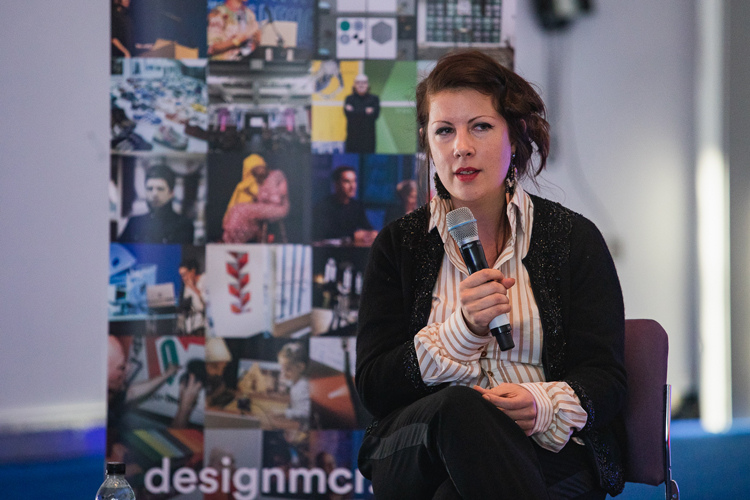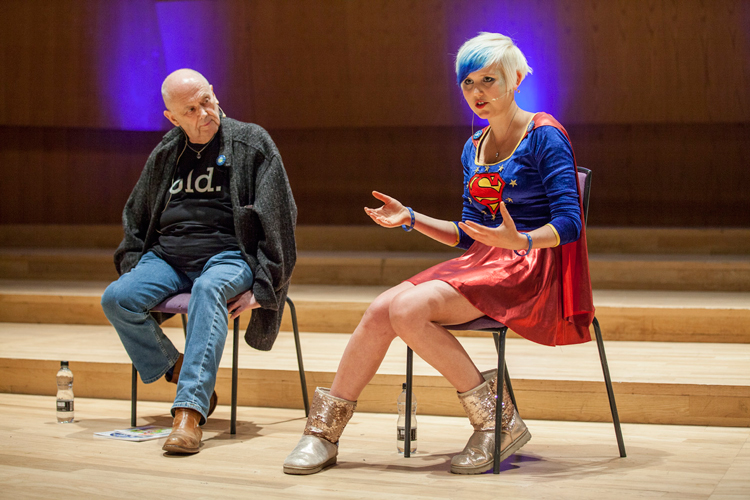5 things we learnt at Design Manchester 2018
With speakers including 2012 Olympics installation designer Kate Dawkins, DesignStudio’s Ben Wright and Kaye Dunnings of Glastonbury’s Shangri-La, there were plenty of top tips being shared at Design Manchester’s D(isrupt)M conference. We sum up their best advice.
Kaye Dunnings: it’s all about experimenting

Kaye Dunnings, the creative director of Shangri-La at Glastonbury Festival, shared her experiences of creating immersive experiences, with arts and underground culture at the core.
Shangri-La is both a stage at Glastonbury and an area for festival-goers to interact with.
She intends for the outside of the spaces she creates to be representative of, and as immersive as, the interiors of that zone.
“I wanted people to feel like they are walking into [the area] they are standing in front of, so everything they saw, felt and smelt was relative to that,” she said. “So, Shangri-La was born.”
From the start right through to now, the idea was always to “try ideas out.”
“If they work, great, if they don’t, great. It’s about experimenting,” she said. “I’m fortunate that Michael and Emily [Eavis] give me that opportunity to just go for it; say what we want, how we want and keep things fresh and interesting.”
Shangri-La has taken many forms over the years, as an ever-changing set and stage, filled with installations and artworks. Themes have ranged from an anarchic dystopian pleasure city, to heaven and hell where corrupt administrations and media hell have been explored.
“We try to make something that will inspire people and make a difference to them in their daily lives,” she adds.
Most recently, the heaven and hell theme was replaced with a recycling concept. It was based on the idea that all the waste left behind in previous years had been transformed into something new, including artworks and “towers of trash”.
Despite some serious messages within the designs, Dunnings said they are never “telling anyone what to think”.
“We are just asking questions and hoping for a response,” she said.
Ben Wright: put design at the heart of everything

Ben Wright, co-founder at DesignStudio, spoke about the importance of incorporating design throughout the whole rebrand process and not just towards the end.
Sharing the story of how he and Paul Stafford set up the studio nearly 10 years ago, he said: “We were really passionate about branding and the power of design, the way that design had the power to affect business outcomes.
“We started to [ask] – if we built a [studio], could we challenge the way a rebrand is done? Could we reimagine the experience for designers?”
They were keen to find a “middle-ground” between how large and boutique studios did things, and to involve designers in everything, from meeting the clients to helping to form the brief.
“One of the core things is putting design at the heart of everything,” he said. “We really believe that designers are problem-solvers, much more than just people who kern typography or create a beautiful colour palette.”
The consultancy, which he said started with “two rented desks in Shoreditch, East London” now has three studios across the world and 60 staff.
Other tips he gave about how to make it work was to learn as much as you can about a brand and its purpose; to leave egos at the door; and look to junior designers and graduates for input as much as senior team members, as this can be where fresh ideas come from.
Talking about the studio’s work rebranding Airbnb in 2014, Wright said they created the new brand out of the concept “belong anywhere”, and the “Bélo” logo, which combines symbols for people, places, love and the letter “A” for Airbnb.
DesignStudio built their own Airbnb listing, stayed with Airbnb hosts around the world and interviewed employees as part of their research.
Wright explains that this ties into their belief that brands are “more than just a logo” and that a “great brand needs a great purpose” so part of their mission was to help the company find this.
Kate Dawkins: inspiration can come from unlikely places

Kate Dawkins, who is known for creating design-driven digital content for live events, shared some of her unusual habits at the start of her talk.
These include collecting wooden toys and Pelican books, which she describes as “stunning pieces of graphic design” as well as photographing and documenting unusual toilet signs.
She also spent a year rolling dice on to a pre-structured grid, using the outcome to create patterns, one a day for 365 days, which she said is very different to her daily work creating interactive displays and installations.
These revelations go to show that inspiration could come from just about anywhere.
Dawkins, creative director at her self-named studio, shared the story of how she created a campaign for Nike, using a stop-motion animation on an iPad to explore ideas and come up with visuals.
“The answer to your mark-making isn’t always in the most obvious place,” she said. “It’s about the playful nature of finding – the answers aren’t always where you think they are.”
Dawkins also spoke about some of her best-known works, including light-emitting diode (LED) visuals for the London 2012 Olympics opening and closing ceremonies. She spoke about how the job, which involved 75,000 LEDs, was made more challenging by the fact that the team was not allowed to take photos inside the stadium prior to its opening.
She also spoke about the World War One Remembered: Passchendaele Centenary work she completed, which involved projecting visuals from 58 projectors onto the 125-metre-wide Cloth Hall in Belgium.
The project won her a British Academy Film Award (BAFTA) and was best in show at the Design Week Awards 2018.
Michael Wolff and Madaleina Kay: realise that individuals can make a difference

Michael Wolff, co-founder at Wolff Olins, which he left in 1983, appeared on stage to speak alongside illustrator and political activist Madeleina Kay, whose alter-ego is European Union (EU) Supergirl. Both had issues they felt strongly about – climate change for Wolff and EU membership for Kay.
Wolff spoke about his desire for people to realise their potential, as individuals, to make a difference.
He said: “As I became a designer and became involved in helping clients [learn to] express themselves, I would find myself saying: what is the point of your business? Why are you doing this?
“I was very clear that there is more to a business that is going to succeed than making money. It is not a vision, a reason to be. It is not a purpose.
“Very often people are not aware of the value they are bringing to the world.”
Wolff said it is important to remember when working with clients and addressing large audiences, that you are speaking with individuals.
“I don’t work for companies, I work for individual people within the companies,” he said. “I work with people who want to move, who want to lead.
He added: “As a designer, my ability to make a difference like anybody else’s depends on the individual people that I energize. I am a huge believer in the power of individual people.”
Madeleina Kay, who appeared on stage in a Supergirl costume, became known for campaigning for the Remain vote during the EU referendum, and this year was voted Young European of the Year by the European Parliament.
As part of her work as an illustrator, she created and presented a satirical Brexit leaflet on stage, and explained that her outfit is designed to make a big “visual impact”, saying that visually strong things work well online.
“My graphic design approach lends itself really well to social media as things that are visually engaging get shared much more widely,” she said.
The activist, who has also created satirical cartoons and illustrations about Brexit, said strong visuals such as those used in the Leave campaign had proved effective, so she was keen to “play them at their own game”.
Anthony Burrill: keep trying new things

Graphic designer and print-maker Anthony Burrill has explored a wide range of avenues throughout his career, from posters and exhibitions to campaigns and books.
Speaking about the myriad of things he has tried, he said: “I think it is about keeping yourself interested and thinking: what do I want to do next? My main motivation is: is it going to be fun? Will I meet new people, go to new places and have an interesting time?”
Burrill became well-known quite early on in his career for his posters featuring slogans such as “Work hard & be nice to people,” printed using traditional letterpress techniques by Adams of Rye printers. It proved popular around the world appearing everywhere from offices to homes.
Other notable works include his Innocent Targets shooting range posters featuring real people, which appeared in a London exhibition for an anti-gun crime awareness campaign. He also made posters following an oil spill using the crude oil that had been spilled as a material to print posters which read: “Oil and water do not mix.”
Recently, he made an acid house record and created a selection of unique covers for it. He said making the record “represents the freedom to do what you’re passionate about and to think of design not just as a commercial endeavour but as a connection you have with… creativity.”
-
Post a comment




